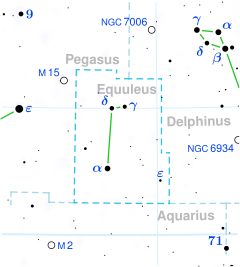Gamma Equulei
| Observation data Epoch J2000 Equinox J2000 |
|
|---|---|
| Constellation | Equuleus |
| Right ascension | 21h 10m 20.50005s |
| Declination | 10° 07′ 53.6763″ |
| Apparent magnitude (V) | 4.69 |
| Characteristics | |
| Spectral type | A9 Sr Eu |
| U−B color index | +0.10 |
| B−V color index | +0.26 |
| R−I color index | +0.10 |
| Variable type | roAp |
| Astrometry | |
| Radial velocity (Rv) | -16.5 ± 0.3 km/s |
| Proper motion (μ) |
RA: 48.74 mas/yr Dec.: mas/yr |
| Parallax (π) | 27.55 ± 0.62mas |
| Distance | 118 ± 3 ly (36.3 ± 0.8 pc) |
| Details | |
| Radius | 2.20 ± 0.12 R☉ |
| Luminosity | 12.8 ± 1.4 L☉ |
| Surface gravity (log g) | 4.47 cgs |
| Temperature | 8,574 K |
| Metallicity [Fe/H] | +0.68 dex |
| Other designations | |
| Database references | |
| SIMBAD | data |
Gamma Equulei (γ Equulei, γ Equ) is a double star in the northern constellation of Equuleus. It is located at a distance of around 118 light-years (36 parsecs) from Earth and has an apparent visual magnitude of 4.7.
The primary component is a chemically peculiar star with a stellar classification of A9 Sr Eu and an apparent magnitude of 4.80. Gamma Equulei undergoes periodic pulsations in luminosity, which places it among the category of roAp stars. The surface magnetic field undergoes long term variation with a period of 91.1 ± 3.6 years, ranging from +577 G to –1,101 G. It has a magnitude 9.05 companion at an angular separation of 1.26 arcseconds.
...
Wikipedia

